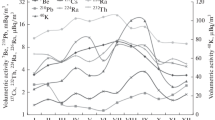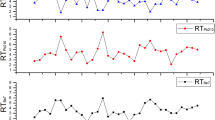The mechanisms for radiation safety validation during large-scale implementation of innovative nuclear technologies in our country are examined. The influence of the physicochemical parameters of radioactive aerosols on safety is shown. A new model-measuring approach is proposed for improving the radiation safety validation mechanisms based on the integration of modern models of aerosol behavior with the means for measuring the physicochemical parameters of aerosols.
Similar content being viewed by others
References
ICRP Publication 68. Dose Coefficients for Worker Intake of Radionuclides, in: Ann. ICRP, 24, No. 4 (1994).
“Science and society: the history of the Soviet atomic project (40s–50s),” Int. Symp. ISAP-96, Dubna, May 14–18, 1996, IzdAT, Moscow (2003), Vol. 3, pp. 121–126.
5th National Report of the Russian Federation: Fulfillment of Obligations Arising from the Joint Convention on the Safety of Spent Fuel Management and on the Safety of Radioactive Waste Management. Sixth Meeting of Contracting Parties to Consider National Reports under the Joint Convention on the Safety of Spent Fuel Management and on the Safety of Radioactive Waste Management, Vienna, Austria, May 21 – June 1, 2018.
V. M. Dekusar, V. S. Kagramanyan, A. G. Kalashnikov, et al., “Analysis of the characteristics of REMIX fuel with multiple recycle in VVER reactors,” Izv. Vyssh. Uchebn. Zaved. Yad. Energet., No. 4, 109–117 (2013).
O. A. Ustinov, S. A. Yakunin, and T. V. Smelova, “A variant of the gas purification system for vitrification of liquid radioactive waste,” At. Energ., 127, No. 2, 92–95 (2019).
V. I. Zemlyanukhin, E. I. Il’ienko, A. N. Kondrat’ev, et al., Radiochemical Processing of Nuclear Fuel at Nuclear Power Plants, Energoatomizdat, Moscow (1989), 2nd ed.
G. E. Kodina and R. N. Krasikova, Methods for Obtaining Radiopharmaceuticals and Radionuclide Generators for Nuclear Medicine, Izd. MEI, Moscow (2014).
S. V. Panchenko, D. A. Pripachkin, A. I. Kryshev, and M. N. Katkova, “Experience in using impurity dispersion models in the urban environment,” At. Energ., 128, No. 5, 282–288 (2020).
R. V. Arutyunyan, D. A. Pripachkin, and K. S. Dolganov, “Assessment of parameters of radioactive aerosol release through air duct system using the SOCRAT/v3 code,” Nucl. Technol. 203, No. 1, 92–100 (2018).
R. V. Arutyunyan, D. A. Pripachkin, O. S. Sorokovikova, et al., “Cross-border transport with small releases of radioactive substances into the atmosphere,” At. Energ., 117, No. 2, 109–112 (2014).
A. K. Budyka, V. P. Kryuchkov, A. A. Molokanov, et al., “Individual impactor,” Invention Patent RU 2290624 C1, 12.27.2006, Appl. No. 2005119674/28 dated June 24, 2005.
A. K. Budyka, V. O. Khmelevskii, D. A. Pripachkin, and A. G. Tsov’yanov, “Modeling and experimental study of the deposition of aerosol particles in a personal impactor,” ANRI, No. 3(58), 27–37 (2009).
D. A. Pripachkin, Yu. N. Khusein, A. K. Budyka, and S. N. Krasnoperov, “Method for determining the parameters of the dispersed composition of radioactive aerosols,” Invention Patent RU 2676557 C1, 09.01.2019, Appl. No. 2018114823 dated April 23, 2018.
A. E. Karev, A. G. Tsov’yanov, B. A. Kukhta, et al., “Method for assessing the deposition of radioactive aerosol particles in the human respiratory tract,” Probl. Bezopasn. Chrezv. Situatsii, No. 5, 23–31 (2016).
D. A. Pripachkin, D. V. Aron, A. K. Budyka, and Yu. N. Khusein, “Infl uence of a collimator on the characteristics of a semiconductor alpha-spectrometer when measuring radioactive aerosols,” At. Energ., 125, No. 2, 109–112 (2018).
R. Pöllänen, K. Peräjärvi, T. Siiskonen, and J. Turunen, “High-resolution alpha spectrometry at ambient air pressure – towards new applications,” Nucl. Instrum. Meth. Phys. Res. Sect. A, 694, 173–178 (2012).
D. A. Afremov, I. V. Zhukov, and D. A. Pripachkin, “The concept of modeling the transfer of fission products during beyond design basis accidents at NPP power units with RBMK-1000 using the MELCOR code,” in: Annual Report of NIKIET 2010, pp. 157–158.
R. V. Arutyunyan, D. A. Pripachkin, O. S. Sorokovikova, et al., “PARRAD system and its tests on real emissions of radioactive substances into the atmosphere,” At. Energ., 121, No. 3, 169–173 (2016).
D. A. Pripachkin and A. K. Budyka, “Influence of aerosol particles parameters on their washout from the atmosphere by raindrops,” Izv. RAN. Fiz. Atm. Okeana, 56, No. 2, 203–209 (2020).
MU 2.6.5.010–2016. 2.6.5, Nuclear Energy and Industry. Substantiation of Boundaries and Operating Conditions of Sanitary Protection Zones and Zones of Observation of Radiation Objects. Methodical Instructions, FMBA Russia, Moscow (2016).
Recommended Methods for Assessing and Predicting the Radiation Consequences of Accidents at Nuclear Fuel Cycle Facilities. Safety Guidelines for the Use of Atomic Energy, NTTs YaRB, Moscow (2017).
Author information
Authors and Affiliations
Corresponding author
Additional information
Translated from Atomnaya Énergiya, Vol. 130, No. 6, pp. 333–338, June, 2021.
Rights and permissions
About this article
Cite this article
Pripachkin, D.A. Model-Measuring Approach to Improving Aerosol Radiation Safety Validation Mechanisms. At Energy 130, 354–359 (2021). https://doi.org/10.1007/s10512-022-00823-1
Received:
Published:
Issue Date:
DOI: https://doi.org/10.1007/s10512-022-00823-1




